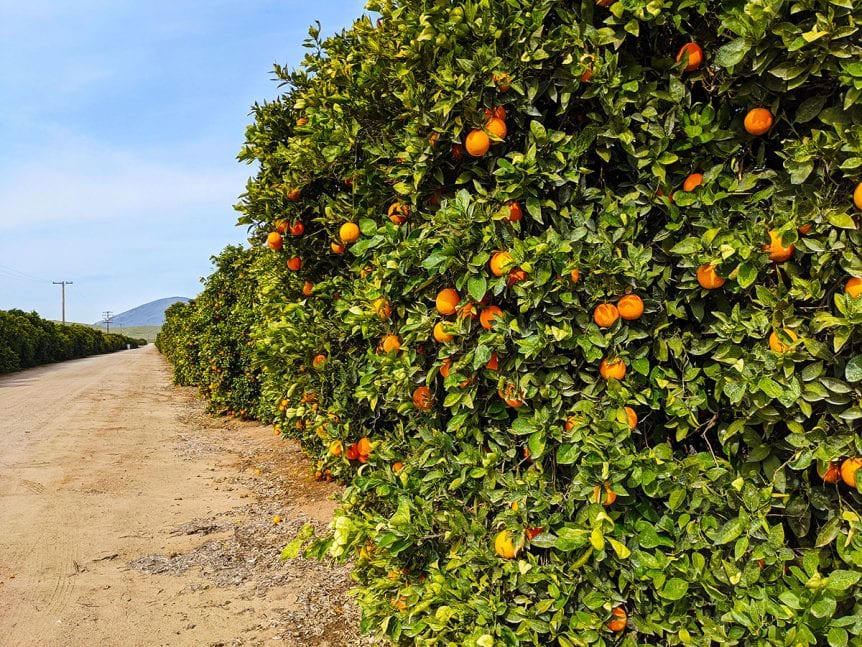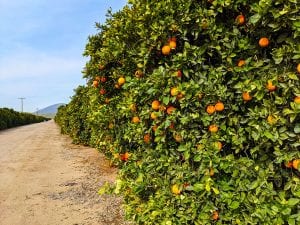California citrus farmers are finding ways to adapt to the changing landscape, as the challenges of this production year come to light. Amid the harvest of California navels, mandarins, and other specialty varieties, two industry leaders share their perspectives on the prospects of the industry.
PRODUCTION QUALITY
CEO and President of Sun Pacific, Al Bates, said that the overall yield for this year’s crop is mediocre, however, “the fruit size is larger and ideal from a consumer perspective.”
The California Department of Food and Agriculture projected a one percent increase in navel orange production from the 2022-2023 production year while also seeing a three percent size increase. Bates said that for his growers, production is about average.
Early in the production season, growers saw the effects of thrip damage on most navel orange blocks. “The thrips damage has been the worst in a very long time and the external quality is not as nice as it normally is,” Bates said.
California Citrus Mutual (CCM) reported that on some blocks, up to 80 percent of fruit was scarred, while overall averages were at 30 percent. Thrips leave scarring on the rind of the fruit but do not affect the interior quality or flavor of the fruit.
“It could be an okay year,” Bates said, but the cost to produce is increasing as margins are shrinking, he explained.
WATER AND WEATHER ISSUES
Jim Phillips, President and CEO of Sunkist, expressed similar concerns regarding production but also emphasized the current state of affairs regarding the Sustainable Groundwater Management Act (SGMA). California citrus farmers need the support of the legislature regarding water access, as the issue is outpacing almost every other concern for growers, said Phillips.
Both Bates and Phillips noted that the substantial amount of rainfall and snowpack over the past two winters are supporting growers in the fight for water access. These wet winters also lead growers to anticipate a shorter crop and larger sizes with increased pressure from thrips generated through a prolonged, mild spring.
However, for most farmers, Bates said, water use will “continue to be a primary concern because there are a lot of trees in the ground as SGMA is implemented over the next few years,” and many are reluctant to fallow their land.
Phillips recommends that growers stay in touch with their local Groundwater Sustainability Agency (GSA), and to “understand the dynamics in particular water districts.” He also urges growers to stay informed about the changing requirements for groundwater pumping and to utilize access to surface water provided by irrigation districts.
INTERNATIONAL MARKET
International competitors in Egypt, South Africa, China, and other countries are taking away the demand for California citrus, and these competitors are meeting the demands for export at a cheaper price than what California growers can accomplish.
Moreover, the disruptions in the supply chain at the start of the COVID-19 pandemic have not been corrected, while there is a “continuation of increasing volume and infrastructure improvements in other countries,” said Phillips.
Phillips said Sunkist has “a lot of product relative to demand,” and is trying to increase “incremental consumption” of California citrus. Seeing that citrus fruits are a “foundational nutrition item” in most American households, he believes that the overall outlook for growers is bright.
INVASIVE PEST PROBLEMS
In Riverside and San Bernardino Counties, backyard citrus trees are the source of the oriental fruit fly invasion. The CDFA is actively working to eradicate the pest, as larvae tunnel into the fruit and cause it to decay. If the oriental fruit fly were to spread to commercial groves, it would have devastating effects on the market.
Phillips said that only a very small portion of Sunkist growers are located in oriental fruit fly quarantine zones. In Ventura County, the Queensland fruit fly is also affecting some lemon growers. “By and large, the state and USDA are doing a good job of imposing mitigation protocols,” Phillips said.
He also noted that the California citrus industry spends around $18 million a year to fight pests and implement management programs.
RESOURCES FOR GROWERS
Bates encourages California citrus farmers to look to certain agencies for support, including CCM, which advocates for farmers regarding issues of water, labor, pests, and disease; and the California Citrus Quality Council, which helps farmers through production challenges on a local and global scale, especially related to Integrated Pest Management (IPM).
Contributing Author:
Lauren McEwen
AgNet West Intern











